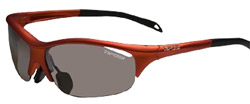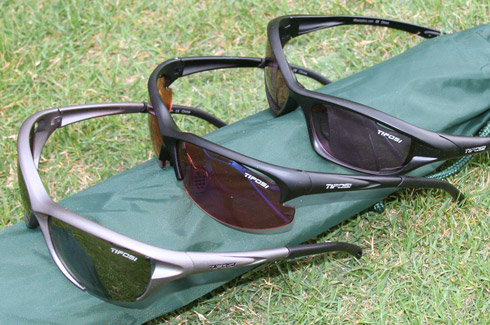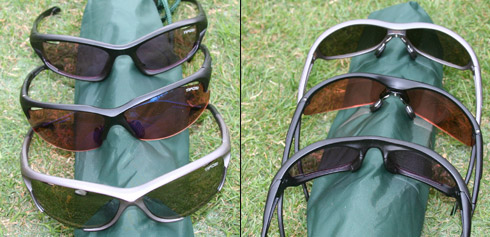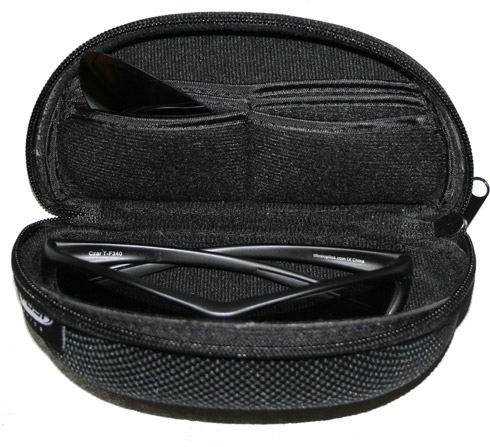![]() Are you the sort of person who has multiple pairs of sunglasses laying about? One in the car, one in your briefcase, one in your jacket pocket. And, hopefully, one in your golf bag (in case you haven’t heard, prolonged exposure to the sun is bad for your eyes. Got it?).
Are you the sort of person who has multiple pairs of sunglasses laying about? One in the car, one in your briefcase, one in your jacket pocket. And, hopefully, one in your golf bag (in case you haven’t heard, prolonged exposure to the sun is bad for your eyes. Got it?).
Tifosi Optics is a sunglasses manufacturer that would like to streamline your sunglasses setup with a nifty interchangeable design that makes each pair of the company’s shades a triple threat. Does that make the Tifosis three times as good as other sunglasses? Read on to find out.
 Tifosi Optics is a Georgia-based company that makes sunglasses primarily made for sports use. The Tifosi name is probably best known in cycling circles, where the company’s shades are praised by bike racers. Tifosi (which is Italian for “sports enthusiast”) has made a push into the golf market in recent years, even developing lenses that are designed specifically for the sport.
Tifosi Optics is a Georgia-based company that makes sunglasses primarily made for sports use. The Tifosi name is probably best known in cycling circles, where the company’s shades are praised by bike racers. Tifosi (which is Italian for “sports enthusiast”) has made a push into the golf market in recent years, even developing lenses that are designed specifically for the sport.
Tifosi has 14 different types of lenses available, and they sell golf-specific version of their frames that come with three sets of lenses that are best suited for most golf conditions. I took three different frame styles – the Kilo, Q3, and Stelvio models – out on the course with me and gave them a thorough test with all three lens types. Here’s what I found:
Construction
All three frames I tested were made of a material called Grilamid TR-90. Tifosi claims this nylon-based material is almost indestructible, which is essential for the removal and insertion of the company’s interchangeable lenses. To change the lenses, you twist the frames and apply slight pressure to the lens. I was a bit nervous doing this at first, but after a couple successful tries it became quick and easy. I found that I could swap out lenses in about one minute, which was very convenient.

This side view shows the vents on the outside corners of the Tifosi Optics frames.
As for the frames, an appreciated design touch that the Kilo and Stelvio styles both employed was adjustable nose pieces. The comfortable rubber pads were easy to adjust for the most comfortable fit. The Q3 model had a fixed nose piece, but still fit very nicely.
All three frames I tried were designed with small vent areas in the upper outside portion of the lens. This allows some air to get in behind the lenses, which keeps you from getting too warm on a hot day. This allows Tifosi to design the frames and lenses to sit very close to your face, which provides maximum protection for your eyes. The vents are at the very edge of your range of vision, and I couldn’t tell they were there when I had the glasses on. They did prompt my wife to ask me if I’d installed the lenses correctly, but the vents are a subtle design touch that doesn’t stand out in a negative way.
The most compelling feature of the Tifosi sunglasses is the ability to change lenses. The golf-specific frames ship with three lens types: The Extreme Contrast (EC) lens, the Golf/Tennis (GT) lens and the All-Conditions Red (AC Red) lens. All three are durable polycarbonate lenses that block 100 percent of UVA/UVB rays, and they also have a patented glare guard coating. The lenses are also “decentered,” which is a way of reducing distortion in your peripheral field of vision.
The EC lens is new for 2006, and the reddish-purple lens is the lightest of the three lenses meant for golf, allowing 36 percent of light to transmit through the lenses (clear lenses allow approximately 98 percent of light to pass through). The EC lens is meant to filter blue light out of the spectrum, increasing contrast in bright light conditions and helping read the breaks and grain on the green. I found that these lenses really made the contours of the golf course – from tee to green – stand out. The greens in particular looked very crisp and clear with the EC lenses. I didn’t magically see the perfect line for every putt, but I did feel like it was easier in general to read greens while using the EC lens.

A look at the three frames I tried From top in the left photo: The Q3 with EC lenses, the Stelvio with AC Red lenses, and the Kilo with GT lenses.
The GT lens is a darker (23 percent light transmission) green color that is designed to help track a golf or tennis ball more clearly against any sort of background. If you have trouble following the flight of the golf ball on sunny days, this lens is for you. It was definitely easier to see the ball against a bright blue sky when wearing the GT lenses.
The AC Red lens is a general-purpose lens that is between the GT and EC lenses in darkness (allowing 27 percent light transmission). This lens is a reddish-gray and is very good for off-course use. I wore the AC Red lenses for driving and other general, non-golf use and really enjoyed how they performed. The lenses do a great job knocking down glare without making everything seem dark, and I found I could even wear them on overcast days and at dusk. Very handy for someone (like me) with sensitive eyes. And, as I harped on earlier, protecting your eyes as much as possible is a smart move.
Esthetics
The three frames I tried were all wrap-style frames, which curve around your head to provide a wider range of vision. Tifosi does make some metal alloy frames that are more minimalist in design, but those don’t have the advantage of interchangeable lenses.
The Q3 frame was my favorite for all-around use. While it doesn’t have adjustable nose pieces like the other two frames I tried, it was still a good fit for me. The Q3 frames I had were a Matte Black finish, and I found them to be sleek and subtle. They also had the smallest lenses of the three frames I tried, which contributed to the sleek look. The Q3 had some nifty little bevels and edges that gave the frames a sport, active appearance. The golf version of the Q3 is also available in Metallic Blue and Metallic Silver.
The Stelvio wasn’t my favorite frame from an esthetic standpoint, but it was probably the most functional. The bottom half of the lenses are open on this model, which means you have a more subtle line where the lenses end in the bottom of your field of vision. The Stelvio also had larger lenses which extended farther down from the frame, which noticeably increased my field of vision and came in handy when trying to read the line of a putt or in any other situation where I was trying to look down and at a point in the distance at the same time. The Stelvio frames were reminiscent of some Bollé sunglasses I’ve seen in recent years, with a sporty, contemporary look that isn’t over the top. I tested the Stelvio in Matte Black, and golf versions are also available in Matte Orange, Gunmetal, Metallic Red, Gloss Yellow, and Tortoise.

The Tifosi Optics golf-specific sunglasses come with a durable zippered case that has pockets for holding the interchangeable lenses.
The Kilo frames split the difference between the Stelvio and the Q3, which makes them an ideal choice for the golf course. The Kilo frames combine the looks of the Q3 with the larger lenses of the Stelvio. That’s a great combination of styling and practicality, and I would gladly wear these glasses on and off the course. I tested the Kilo in Iron (a silver-gray), and golf-specific models are available in Metallic Silver, Metallic Blue, Metallic Red, Matte Black and Matte Orange.
Prescription Options
I wear contacts, so I didn’t test out the prescription versions of the Tifosi Optics line. But the Stelvio and Kilo are both available with an RX Adaptor that allows you to put prescription lenses on the inside of the Tifosi lenses. And Tifosi has partnered with Sola Technologies to offer prescription lenses in six different styles. Erik tested some prescription Tifosi sunglasses, and here’s what he thought:
I agree with all that you say about the fit and finish. I have the Czar frame and found them to be comfortable, durable, and lightweight. Unfortunately, my prescription (from a week-old eye exam) was not met exactly. When switching between my contacts or regular glassses and the Tifosi prescription sunglasses, anything viewed out the bottom half of the lenses appears closer to me, including the ball sitting in the fairway or on the tee. This was very disconcerting and I found myself hitting shots all over the clubface as my body was trying to adjust to what my eyes were telling it was not a normal looking setup.
Tifosi confirmed that they got my proper prescription, and offered to re-do the lenses free of charge, but I’ve not yet taken advantage of that offer. It is likely a very small change, but one that has made at least the lenses I first received virtually unusable for me when playing golf.
Conclusion
My experience with Tifosi Optics sunglasses was excellent. I enjoyed the ability to change lenses for different conditions – EC for most golf situations, GT for the brightest, sunniest days on the course, and AC Red for off-course use. I thought the frame styles were comfortable and stylish, and the interchangeable lenses were easy to use.
There are two main reasons I would recommend Tifosi Optics sunglasses to other golfers. First, I liked that these glasses are versatile enough to be worn under any circumstances. I would rather have one pair of sunglasses that I can take everywhere instead of specific sunglasses for different types of activities. Tifosi made that happen.
Second, the Tifosi Optics sunglasses are a great value. The golf versions of the company’s frames retail for around $60, which is a good price for glasses with one pair of lenses. When you consider you’re getting three sets of lenses – along with a durable zippered hard case and a drawstring bag that you can use to clean the lenses – with the Tifosis, I think you’re getting a great deal when you buy them. In short: Three sets of lenses, two thumbs up.

I found this to be a very useful and well written review. I have been trying to find some golf specific glasses with an adjustable nose piece since my old Adidas broke. Thanks.
Don,
where can these be purchased? And, should they be polarized?….
Thanks,
the Exotica Man
Don,
where can these be purchased? And, should they be polarized?….
Thanks,
the Exotica Man
I just got my first pair at Outdoordevices.com and I do love them.
I know this is a old review but you did a good job on it.
These actually aren’t golf specific frames, although the GT lens may be. The Stelvio is a popular triathlon glasses model, for example. They are great value, however, and I’m glad they help with golf as well.
Polarization is not necessary for a game of golf, unless you are concerned about the ponds, have very photosensitive eyes or are playing multiple rounds and are concerned about eye fatigue. You can purchase the following polarized glasses models: http://www.tifosioptics.com/fototec/index.html
Try Peak Vision Sports Golf specific glasses if your seeking prescription sunglasses. They don’t require an added insert for the Rx. It was the best money I have spent in my 50 years. Outstanding quality. They even come in Rap-a-round Rx’s, which is extremely hard to find.
Where are tifosi sunglasses made?